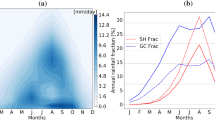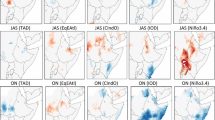Abstract
We investigated teleconnections of rainfall time series in the central Nile Basin (Sudan and South Sudan) with localities in the global sea surface temperature (SST) field, using monthly rainfall data from 11 gauging stations from 1960 to 1999. Annual rainfall ranged from 100 mm in the north to more than 700 mm in the south, and all stations had a strong contrast between rainy and dry seasons with rainless dry periods of several months. Rainfall time series at the stations were categorized as strongly seasonal, with precipitation concentration index exceeding 16 and seasonality index exceeding 0.9. The rainfall stations were classified into four zones on the basis of annual rainfall, seasonality, and cross-correlations among the stations. We calculated cross-correlations of interannual rainfall time series in summer (July and August) with the global SST field. For short lag times (0 or 1 month), summer rainfall in Zones I and II (northern arid regions) had significant correlations with SST over the eastern Mediterranean Sea and southern Indian Ocean, summer rainfall in Zone III (semiarid region) had significant negative correlations with SST over the Indian Ocean, and summer rainfall in Zone IV (southern wet region) had significant correlations with SST over tropical areas and the southwestern Pacific Ocean. For long lag times (3–6 months), Nile Basin summer rainfall time series had significant correlations with SST in various regions of the Atlantic and Indian Oceans but not the Pacific Ocean. Rainfall in Zones I and II had positive correlations (significance level < 0.01) with SST south of Greenland and around the Azores Islands and negative correlations with SST south of Madagascar; rainfall in Zone III had negative correlations with SST in parts of the Indian Ocean; and rainfall in Zone IV had significant positive correlations with SST southwest of South Africa and negative correlations with SST in the southwestern Indian Ocean. In sum, rainfall in three of the zones (I, II, and IV) had significant positive and negative correlations with SST in parts of the Indian and Atlantic Oceans. For each of these zones, one positive correlation and one negative correlation were selected and correlations with the time series of the difference between the two SST records were calculated. Correlations of Nile Basin rainfall with the SST differences were stronger than the original positive and negative correlations. The resulting time series of SST difference were applied to an artificial neural network to predict summer rainfall, yielding satisfactory correlation coefficients between the observed and predicted summer rainfall (r > 0.70).














Similar content being viewed by others
References
Apaydin H, Erpul G, Bayramin I, Gabriels D (2006) Evaluation of indices for characterizing the distribution and concentration of precipitation: a case for the region of South-eastern Anatolia Project, Turkey. J Hydrol 328:726–732
Ayoade JO (1970) The seasonal incidence of rainfall. Weather 25:414–418
Bärring L, Hulme M (1991) Filters and approximate confidence-interval for interpreting rainfall anomaly indexes. J Clim 4:837–847
Behera S, Yamagata T (2001) Subtropical SST dipole events in the southern Indian ocean. Geophys Res Lett 28:327–330
Bello NJ (1998) Evidence of climate change based on rainfall records in Nigeria. Weather 53:412–418
Camberlin P (1997) Rainfall anomalies in the source region of the Nile and their connection with the Indian summer monsoon. J Clim 10:1380–1392
Chen CJ, Georgakakos AP (2015) Seasonal prediction of East African rainfall. Int J Climatol 35:2698–2723. https://doi.org/10.1002/joc.4165
Dash NB, Panda SN, Remesan R, Sahoo N (2010) Hybrid neural modeling for groundwater level prediction. Nat Hazards Earth Syst Sci 19:1251–1263
de Luis M, Gonzalez-Hidalgo JC, Longares LA (2010) Is rainfall erosivity increasing in the Mediterranean Iberian Peninsula? Land Degrad Dev 21:139–144
de Luis M, Gonz´alez-Hidalgo JC, Brunetti M, Longares LA (2011) Precipitation concentration changes in Spain 1946–2005. Nat Hazards Earth Syst Sci 11:1259–1265
Diro GT, Grimes DIF, Black E (2011) Teleconnections between Ethiopian summer rainfall and sea surface temperature: part I-observation and modelling. Clim Dyn 37:103–119
Elagib NA (2010) Exploratory analysis of rain days in central Sudan. Meteorol Atmos Phys 109:47–59
Elagib NA (2011) Changing rainfall, seasonality and erosivity in the hyper-arid zone of Sudan. Land Degrad Dev 22:505–512
Elagib NA, Elhag MM (2011) Major climate indicators of ongoing drought in Sudan. J Hydrol 409:612–625
Elagib NA, Mansell MG (2000) Climate impacts of environmental degradation in Sudan. GeoJournal 50:311–327
Fontaine B, Gaetani M, Ullmann A, Roucou P (2011) Time evolution of observed July–September sea surface temperature-Sahel climate teleconnection with removed quasi-global effect (1900–2008). J Geophys Res. https://doi.org/10.1029/2010JD014843
Goyal MK, Ojha CSP (2012) Downscaling of surface temperature for lake catchment in an arid region in India using linear multiple regression and neural networks. Int J Climatol 32:552–566
Hameed S, Riemer N (2012) Relationship of Sahel precipitation and atmospheric centers of action. Adv Meteorol. https://doi.org/10.1155/2012/953853
Kumbuyo C, Yasuda H, Kitamura Y, Shimizu K (2014) Fluctuation of rainfall time series in Malawi. An analysis of selected areas. Geofizika 31:13–34. https://doi.org/10.15233/gfz.2014.31.1
Larsson H (1996) Relationships between rainfall and sorghum, millet and sesame in the Kassala province, eastern Sudan. J Arid Environ 32:211–223
Livada I, Asimakopoulos DN (2005) Individual seasonality index of rainfall regimes in Greece. Clim Res 28:155–161
Michiels P, Gabries D, Hartmann R (1992) Using the seasonal and temporal precipitation concentration index for characterizing the monthly rainfall distribution in Spain. CATENA 19:43–58
Middleton N, Thomas D (1997) World atlas of desertification. Wiley, New York
Nicholson SE (2011) Dryland climatology. Cambridge University Press, Cambridge, pp 196–200
Nilsson P, Cintia BU, Berndtsson R (2006) Monthly runoff simulation: comparing and combining conceptual and neural network models. J Hydrol 321:344–363
Oliver JE (1980) Monthly precipitation distribution: a comparative index. Prof Geogr 32:300–309
Olsson J, Uvo CB, Jinno K (2001) Statistical atmospheric downscaling of short-term extreme rainfall by neural networks. Phys Chem Earth Part B Hydrol Oceans 26:695–700
Osman YZ, Shamseldin AY (2002) Qualitative rainfall prediction models for central and southern Sudan using El Nino—Southern Oscillation and Indian Ocean sea surface temperature indices. Int J Climatol 22:1861–1878
Pryor SC, Schoof JT (2008) Changes in precipitation seasonality over the contiguous USA. J Geophys Res Atmos. https://doi.org/10.1029/2008JD010251
Rayner NA, Parker DE, Horton EB, Folland CK, Alexander LV, Rowell DP, Kent EC, Kaplan A (2003) Global analyses of sea surface temperature, sea ice, and night marine air temperature since the late nineteenth century. J Geophys Res. https://doi.org/10.1029/2002JD002670
Rayner NA, Brohan P, Parker DE, Folland CK, Kennedy JJ, Vanicek M, Ansell T, Tett SFB (2006) Improved analyses of changes and uncertainties in sea surface temperature measured in situ since the mid-nineteenth century: the HadSST2 data set. J Clim 19:446–469
Rishmawi K, Prince SD, Xue YK (2016) Vegetation responses to climate variability in the northern arid to sub-humid zones of Sub-Saharan Africa. Remote Sens 8:910. https://doi.org/10.3390/rs8110910
Rodríguez-Fonseca B, Polo I, Serrano E, Castro M (2006) Evaluation of the north Atlantic SST forcing on the European and Northern African winter climate. Int J Climatol 26:179–191
Saji NH, Yamagata T (2003) Possible impacts of Indian Ocean dipole mode events on global climate. Clim Res 25:151–169
Shankar D, Shetye SR, Joseph PV (2007) Link between convection and meridional gradient of sea surface temperature in the Bay of Bengal. J Earth Syst Sci 116:385–406
Singh P, Borah B (2013) Indian summer monsoon rainfall prediction using artificial neural network. Stoch Env Res Risk A 27:1585–1599
Smith IN, McIntosh P, Ansell TJ, Reason CJC, McInnes K (2000) Southwest western Australian winter rainfall and its association with ocean climate variability. Int J Climatol 20:1913–1930
Srivastava P, McNair JN, Johnson TE (2006) Comparison of process-based and artificial neural network approaches for stream flow modeling in an agricultural watershed. J Am Water Resour Assoc 42:545–563
Sumner G, Homar V, Ramis C (2001) Precipitation seasonality in eastern and southern coastal Spain. Int J Climatol 21:219–247
Traore S, Zerbo L, Schmidt M, Thiombiano L (2012) Acacia communities and species responses to soil and climate gradients in the Sudano-Sahelian zone of West Africa. J Arid Environ 87:144–152
Uvo CB, Repelli CA, Zebiak SE, Kushnir Y (1998) The relationships between tropical Pacific and Atlantic SST and northeast Brazil monthly precipitation. J Clim 11:551–562
Uvo CB, Tolle U, Berndtsson R (2000) Forecasting discharge in Amazonia using artificial neural networks. Int J Climatol 20:1495–1507
Willcocks TJ, Twomlow SJ (1992) An evaluation of sustainable cultural practices for rainfed sorghum production on Vertisols in east Sudan. Soil Till Res 24:183–198
World Meteorological Organization (2004) Forecasting El Nino: science’s gift to the twenty-first century. World Climate Programme, Africa. Flip Side of Science, 39p
Yasuda H, Berndtsson R, Saito T, Anyoji H, Zhang X (2009) Prediction of Chinese Loess plateau summer rainfall using Pacific Ocean spring sea surface temperature. Hydrol Process 23:719–729
Yuan F, Yasuda H, Berndtsson R, Uvo CB, Zhang L, Hao Z, Wang X (2015) Regional sea surface temperatures explain spatial and temporal variation of summer precipitation in the source region of the Yellow River. Sci J, Hydrol. https://doi.org/10.1080/02626667.2015.1035658
Zheng J, Li J, Feng J (2014) A dipole pattern in the Indian and Pacific oceans and its relationship with the East Asian summer monsoon. Res Lett, Env. https://doi.org/10.1088/1748-9326/9/7/074006
Acknowledgements
The authors gratefully acknowledge financial support by the Science Research project of the Japan Society for the Promotion of Science (No. 23404014) and the Joint Research Program of the Arid Land Research Center, Tottori University.
Author information
Authors and Affiliations
Corresponding author
Rights and permissions
About this article
Cite this article
Yasuda, H., Panda, S.N., Abd Elbasit, M.A.M. et al. Teleconnection of rainfall time series in the central Nile Basin with sea surface temperature. Paddy Water Environ 16, 805–821 (2018). https://doi.org/10.1007/s10333-018-0671-x
Received:
Revised:
Accepted:
Published:
Issue Date:
DOI: https://doi.org/10.1007/s10333-018-0671-x




